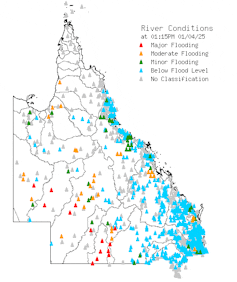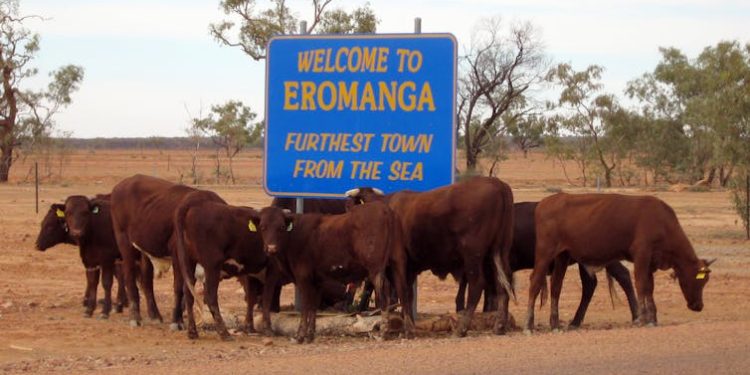The small town of Eranga du Queensland presents itself as the most distant Australian city from the sea. But this week, an ocean of fresh water has arrived.
Mousson’s time struck the country of the normally arid chain from the interior of Queensland. Some cities had two years of rain in a few days. These flat grazing lands now look like an inner sea.
A man from New South Wales is still missing and dozens of people have been evacuated. Others are preparing to be cut, potentially for weeks. And Graziers brings in major cattle loss – more than 100,000 and climbing. In some regions, the flood is worse than 1974, the wet year ever recorded in Australia.
Why so much rain? Tropical air and water loaded was brought far inside the ocean lands in the north and east. This can occur under normal climate variability. But our oceanic temperatures are the highest ever recorded, which overeat the water cycle.
In the coming weeks, this huge volume of water would make its way through the canals perhaps 600 km to fill Kati Thanda-Lake Eyre, the ephemeral lake that appears in northern South Australia. It is likely that it will be an Eyre lake for ages.
During the first three months of the year, fatal broken floods hit northern Queensland before Cyclone Alfred followed an extreme from the South and touches the ground in the Southeast Queensland, bringing generalized winds and rains and leaving expensive repair bills. Now the rain has come inside the land.

AAP
Why so much rain in arid areas?
Some meteorologists have nicknamed this event a pseudo-monsoon. Indeed, the normal Australian monsoon does not reach as far south – the torrential rains of the wet season of the monsoon tend to get closer to the north coasts.
Because the Arafura and Timor seas in the north are unusually hot, the evaporation rates have increased. Once in the air, this water vapor makes very humid conditions. These air masses are even more humid than normal tropical air because they have flowed from the equator. Many Queenslanders can guarantee intense humidity.
But there is a second factor at work. Currently, Australia’s climate is influenced by a positive southern annular mode. This means that the belt of intense winds west that blow through the southern ocean has been pushed further south, causing a training effect which can cause more summer rain in southeast of Australia, to the interior of Queensland. This natural climatic driver noted that the eastern winds have blown without interruption of Fiji, wearing an even more humid air inside the land.

Meteorology office, CC by
These two row tropical air flows were led in the colder heights of the atmosphere by higher and surface low pressure tires, triggering torrential rains on large areas of the outback
While these wet air masses have now thrown most of their water, more rain arrives following Dianne short-term cyclone off the coast of Australia. These rains will not be as intense but can drive more flood peaks on already saturated watersheds.
This is why it was so humid in what is normally an exceptionally dry part of Australia.
What is it in the land of the canal?
Many Australians have never gone to the country far from the canal. It is a striking landscape, marked by ancient and braided river channels.
Even for an area known for drought cycles, the precipitation totals are extreme. It is a very rare event.
The people who live there should be resilient and self -sufficient. But farmers and grazers are preparing for horrible livestock losses. Livestock can drown in flood waters, but a common spell succumbs to pneumonia after spending too long in the water. Once the water has dropped the canals, it will leave behind a marketing and sticky mud. This can be fatal for cattle and native animals, which can be unable to move.
Where is the water going?
Few of these temporary interior seas will never reach the ocean.
Part of the rain fell into the Darling river watershed, where it will flow and meet the Murray. The darling is often filled with summer rains, while the Murray gets more water from the fall and winter rains. This water will eventually reach the southern ocean.
But most of the rain fell more inside the land. The watering waters through the canals will go south, slowly flowing along the flat ground for weeks until it crosses the South Australian border and begins to fill Kati Thanda-Lake Eyre. Here, the waters will stop, more than 300 km from the nearest ocean at Port Augusta, and will fill out what is normally a huge salty depression and the lowest point in Australia, 15 meters from sea level.
When Kati Thanda-Lake Eyre fills, it creates an extraordinary spectacle. Millions of briefs of brine will hatch eggs in dry soil. This sudden abundance will attract water birds in millions, while the fish transported in flood waters will appear and eat the shrimp. Then there are remarkable shrimp shrimps, interior hibernation crabs and Hardyhead fish adapted to salt.

Mandy Creighton / Shutterstock
The rain event will send enough water to keep Lake Eyre full for several months and it is generally up to two years for it to dry again. We can expect to see a huge form of lake – the size of a small European country. Amateur ornithologists and biologists will flock to the region to see a temporary sea in the desert.
Finally, the intense sun of the outback will evaporate each last drop of flood waters, leaving behind salty soil and shrimp eggs for the next large rains.
While the climate continues to warm up, we can expect to see more torrential rain discharges suddenly like this, followed by rapid drying periods.


